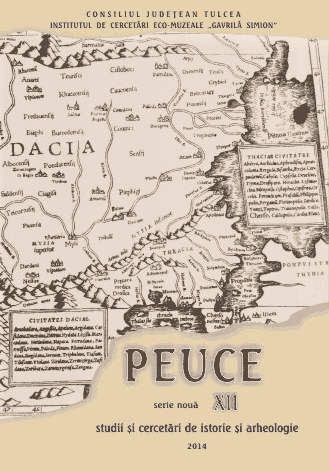Akinakai de tip Soloha în contextul unei noi descoperiri de la Nistrul de Jos
Soloha-type akinakes in the Context of the New Find at Lower Dnestr
Author(s): Denis A. Topal, Stanislav V. Ţerna, Sergiu PopoviciSubject(s): Archaeology
Published by: Institutul de Cercetari Eco-Muzeale Tulcea - Institutul de Istorie si Arheologie
Keywords: Purcari; Scythian culture; akinakes; Solokha type; sword; dagger; burial mound; cultura scitică; akinakes; tip Soloha; spadă; pumnal, tumul
Summary/Abstract: In 2011, a barrow (no. 7) was excavated near the village of Purcari (Ștefan Vodă district, Republic of Moldova). The main Scythian burial contained the skeleton of a male, 30-35 years old, extended on the back, with the head to the W. In the SW part of the burial chamber, a Heraclea-type amphora, two iron spearheads and two javelins were placed. The amphora bears a stamp with the inscription “Eurydamos”, thus ascribing it to the so-called early manufacturing group (5th - late 4th century B.C.). An Attic black-glazed saltcellar with concave walls was located near the right shoulder. A pair of anatomically-shaped bronze greaves (cnemides) was found on the legs. On the chest of the deceased several fragments of iron plates were identified, which could have been the remains of a flat body armour made of leather, covered with iron plates. The burial also contained approx. 110 bronze arrowheads concentrated in different locations. The preliminary chronological analysis of the grave inventory shows that the most convenient chronological framework for this grave is the late 5th c. B.C. An akinakes-type iron sword decorated in zoomorphic style was placed across the hips, with the hilt in the left hand. The pommel extends on each side into two semi-abstract bird heads. Akinakes analogies are spread over a vast territory from the lower Danube to Southern Ural in 450-350 B.C. Ornithomorphic motifs in the design of Scythian akinakes appear in the early 6th c. BC. The specific shape of the pommel ornate with stylized bird heads (or claws of a bird of prey) and an eye at the bottom is the stylistic development of earlier pommel types decorated in a more realistic manner. This article sets out to gather swords and daggers with such stylistic traits in a separate type called Solokha type (after the famous Royal barrow with an akinakes of this type). In this paper we discuss the chronology of complexes with Solokha type akinakes and establish the main chronological limits for their wide distribution between 410—370 BC. Special attention is drawn to the stray finds of such swords and daggers, which spread from Bulgaria in the West to Tyumen in the East. Rezumat: În anul 2011 a fost cercetat tumulul scitic nr. 7 de lângă satul Purcari (raionul Ștefan Vodă, Republica Moldova) al cărui mormânt principal a aparținut unui bărbat cu o vârstă cuprinsă între 30-35 ani. Defunctul a fost depus întins pe spate cu capul spre vest. În partea de sud-vest a camerei funerare se aflau vârfuri de lance de diferite tipuri și o amforă de tip Heraclea cu ștampila „Eὐρυδάμο”, indiciu pentru o datare timpurie (sf. sec. V – anii `90 ai sec. IV î.Hr.). Lângă umărul drept era un vas attic de tip „solniță”, acoperit cu firnis negru. Pe gambele defunctului se aflau două cnemide din bronz, iar în regiunea oaselor toracelui a fost identificată o aglomerare de fragmente de plăcuțe din fier, care, probabil, proveneau de la o armură pe suport din piele. Mormântul mai conținea cca. 110 vârfuri d
Journal: Peuce (Serie Nouă) - Studii şi cercetari de istorie şi arheologie
- Issue Year: XII/2014
- Issue No: 12
- Page Range: 9-67
- Page Count: 59
- Language: Romanian

